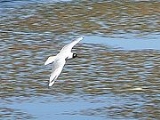
Andean Gull
Encyclopedia
The Andean Gull is a species of gull
in the Laridae family. As is the case with many gulls, it has traditionally been placed in the genus
Larus
.
It is found in Argentina
, Bolivia
, Chile
, Colombia
, Ecuador
, and Peru
.
At 45-48 cm (18-19 in) long, it is large for a black-headed gull (it is the largest gull with that kind of plumage in the Americas). Its natural habitat
is unusual in that it is known to inhabit very high elevations, usually no lower than 3,000 m. At the elevation, it may be variously found around river
s, freshwater lake
s, saline marsh
es, and pastureland. It feeds on a variety of prey items including insect
s and worm
s taken on fields and grasslands; it also catches aerial insects and eats some garbage when available. The Andean Gull nests in small scattered colonies, sometimes even as solitary pairs, in small, isolated ponds.
Gull
Gulls are birds in the family Laridae. They are most closely related to the terns and only distantly related to auks, skimmers, and more distantly to the waders...
in the Laridae family. As is the case with many gulls, it has traditionally been placed in the genus
Genus
In biology, a genus is a low-level taxonomic rank used in the biological classification of living and fossil organisms, which is an example of definition by genus and differentia...
Larus
Larus
Larus is a large genus of gulls with worldwide distribution . Many of its species are abundant and well-known birds in their ranges...
.
It is found in Argentina
Argentina
Argentina , officially the Argentine Republic , is the second largest country in South America by land area, after Brazil. It is constituted as a federation of 23 provinces and an autonomous city, Buenos Aires...
, Bolivia
Bolivia
Bolivia officially known as Plurinational State of Bolivia , is a landlocked country in central South America. It is the poorest country in South America...
, Chile
Chile
Chile ,officially the Republic of Chile , is a country in South America occupying a long, narrow coastal strip between the Andes mountains to the east and the Pacific Ocean to the west. It borders Peru to the north, Bolivia to the northeast, Argentina to the east, and the Drake Passage in the far...
, Colombia
Colombia
Colombia, officially the Republic of Colombia , is a unitary constitutional republic comprising thirty-two departments. The country is located in northwestern South America, bordered to the east by Venezuela and Brazil; to the south by Ecuador and Peru; to the north by the Caribbean Sea; to the...
, Ecuador
Ecuador
Ecuador , officially the Republic of Ecuador is a representative democratic republic in South America, bordered by Colombia on the north, Peru on the east and south, and by the Pacific Ocean to the west. It is one of only two countries in South America, along with Chile, that do not have a border...
, and Peru
Peru
Peru , officially the Republic of Peru , is a country in western South America. It is bordered on the north by Ecuador and Colombia, on the east by Brazil, on the southeast by Bolivia, on the south by Chile, and on the west by the Pacific Ocean....
.
At 45-48 cm (18-19 in) long, it is large for a black-headed gull (it is the largest gull with that kind of plumage in the Americas). Its natural habitat
Habitat
* Habitat , a place where a species lives and grows*Human habitat, a place where humans live, work or play** Space habitat, a space station intended as a permanent settlement...
is unusual in that it is known to inhabit very high elevations, usually no lower than 3,000 m. At the elevation, it may be variously found around river
River
A river is a natural watercourse, usually freshwater, flowing towards an ocean, a lake, a sea, or another river. In a few cases, a river simply flows into the ground or dries up completely before reaching another body of water. Small rivers may also be called by several other names, including...
s, freshwater lake
Lake
A lake is a body of relatively still fresh or salt water of considerable size, localized in a basin, that is surrounded by land. Lakes are inland and not part of the ocean and therefore are distinct from lagoons, and are larger and deeper than ponds. Lakes can be contrasted with rivers or streams,...
s, saline marsh
Marsh
In geography, a marsh, or morass, is a type of wetland that is subject to frequent or continuous flood. Typically the water is shallow and features grasses, rushes, reeds, typhas, sedges, other herbaceous plants, and moss....
es, and pastureland. It feeds on a variety of prey items including insect
Insect
Insects are a class of living creatures within the arthropods that have a chitinous exoskeleton, a three-part body , three pairs of jointed legs, compound eyes, and two antennae...
s and worm
Worm
The term worm refers to an obsolete taxon used by Carolus Linnaeus and Jean-Baptiste Lamarck for all non-arthropod invertebrate animals, and stems from the Old English word wyrm. Currently it is used to describe many different distantly-related animals that typically have a long cylindrical...
s taken on fields and grasslands; it also catches aerial insects and eats some garbage when available. The Andean Gull nests in small scattered colonies, sometimes even as solitary pairs, in small, isolated ponds.

